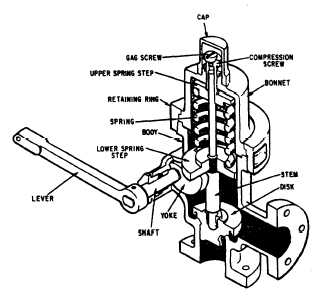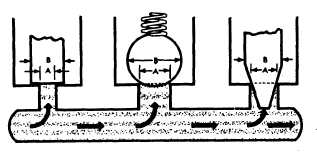Smaller relief valves, similar in design and
operation to the main system relief valve, are often
used in isolated parts of the system where a check
valve or directional control valve prevents pressure
from being relieved through the main system relief
valve and where pressures must be relieved at a
set point lower than that provided by the main
system relief. These small relief valves are also
used to relieve pressures caused by thermal
expansion (see glossary) of the fluids.
Figure 6-11 shows a typical relief valve. System
pressure simply acts under the valve disk at the
inlet to the valve. When the system pressure
exceeds the force exerted by the valve spring, the
valve disk lifts off of its seat, allowing some of
the system fluid to escape through the valve outlet
until the system pressure is reduced to just below
the relief set point of the valve.
All relief valves have an adjustment for
increasing or decreasing the set relief pressure.
Some relief valves are equipped with an adjusting
screw for this purpose. This adjusting screw is
usually covered with a cap, which must be
removed before an adjustment can be made. Some
type of locking device, such as a lock nut, is
usually provided to prevent the adjustment from
changing through vibration. Other types of relief
valves are equipped with a handwheel for making
adjustments to the valve. Either the adjusting
screw or the handwheel is turned clockwise to
increase the pressure at which the valve will open.
In addition, most relief valves are also provided
Figure 6-11.—Relief valve.
with an operating lever or some type of device to
allow manual cycling or gagging the valve open
for certain tasks.
Various modifications of the relief valve
shown in figure 6-11 are used to efficiently serve
the requirements of some fluid power systems;
however, this relief valve is unsatisfactory for
some applications. To give you a better under-
standing of the operation of relief valves, we will
discuss some of the undesirable characteristics of
this valve.
A simple relief valve, such as the one
illustrated in figure 6-11, with a suitable spring
adjustment can be set so that it will open when
the system pressure reaches a certain level, 500
psi for example. When the valve does open, the
volume of flow to be handled may be greater than
the capacity of the valve; therefore, pressure in
the system may increase to several hundred psi
above the set pressure before the valve brings the
pressure under control. A simple relief valve will
be effective under these conditions only if it is very
large. In this case, it would operate stiffly and the
valve element would chatter back and forth. In
addition, the valve will not close until the system
pressure decreases to a point somewhat below the
opening pressure.
The surface area of the valve element must be
larger than that of the pressure opening if the
valve is to seat satisfactorily as shown in figure
6-12. The pressure in the system acts on the valve
element open to it. In each case in figure 6-12,
the force exerted directly upward by system
pressure when the valve is closed depends on the
area (A) across the valve element where the
element seats against the pressure tube. The
moment the valve opens, however, the upward
force exerted depends on the horizontal area (B)
of the entire valve element, which is greater than
area A. This causes an upward jump of the valve
element immediately after it opens, because the
Figure 6-12.—Pressure acting on different areas.
6-7




